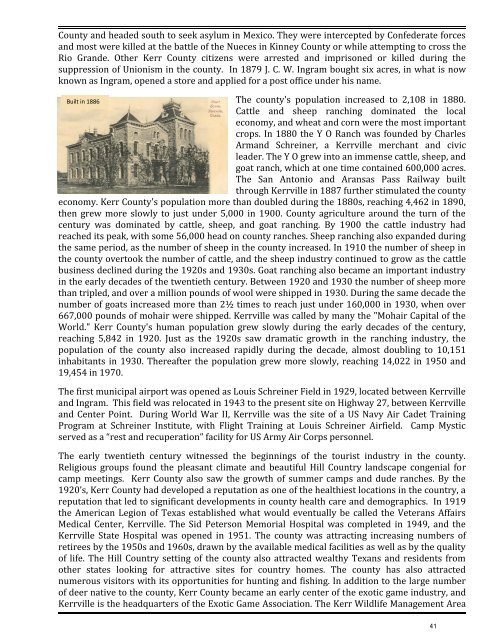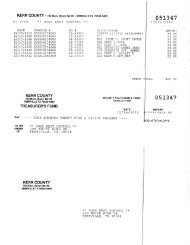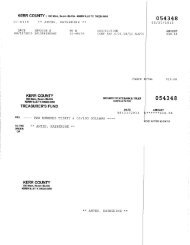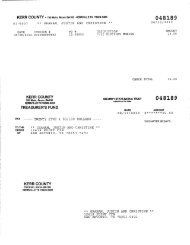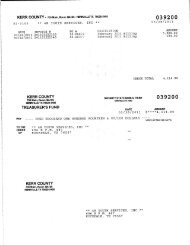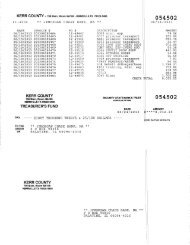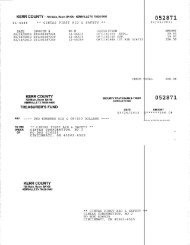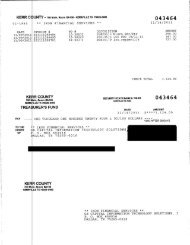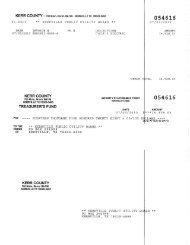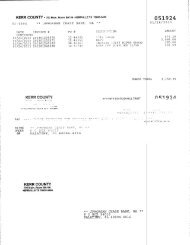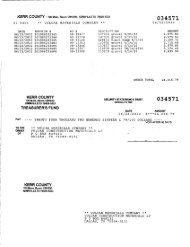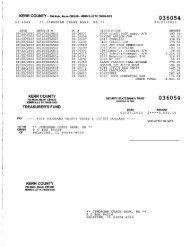to view the Kerr County Budget
to view the Kerr County Budget
to view the Kerr County Budget
You also want an ePaper? Increase the reach of your titles
YUMPU automatically turns print PDFs into web optimized ePapers that Google loves.
<strong>County</strong> and headed south <strong>to</strong> seek asylum in Mexico. They were intercepted by Confederate forces<br />
and most were killed at <strong>the</strong> battle of <strong>the</strong> Nueces in Kinney <strong>County</strong> or while attempting <strong>to</strong> cross <strong>the</strong><br />
Rio Grande. O<strong>the</strong>r <strong>Kerr</strong> <strong>County</strong> citizens were arrested and imprisoned or killed during <strong>the</strong><br />
suppression of Unionism in <strong>the</strong> county. In 1879 J. C. W. Ingram bought six acres, in what is now<br />
known as Ingram, opened a s<strong>to</strong>re and applied for a post office under his name.<br />
Built in 1886<br />
The county's population increased <strong>to</strong> 2,108 in 1880.<br />
Cattle and sheep ranching dominated <strong>the</strong> local<br />
economy, and wheat and corn were <strong>the</strong> most important<br />
crops. In 1880 <strong>the</strong> Y O Ranch was founded by Charles<br />
Armand Schreiner, a <strong>Kerr</strong>ville merchant and civic<br />
leader. The Y O grew in<strong>to</strong> an immense cattle, sheep, and<br />
goat ranch, which at one time contained 600,000 acres.<br />
The San An<strong>to</strong>nio and Aransas Pass Railway built<br />
through <strong>Kerr</strong>ville in 1887 fur<strong>the</strong>r stimulated <strong>the</strong> county<br />
economy. <strong>Kerr</strong> <strong>County</strong>'s population more than doubled during <strong>the</strong> 1880s, reaching 4,462 in 1890,<br />
<strong>the</strong>n grew more slowly <strong>to</strong> just under 5,000 in 1900. <strong>County</strong> agriculture around <strong>the</strong> turn of <strong>the</strong><br />
century was dominated by cattle, sheep, and goat ranching. By 1900 <strong>the</strong> cattle industry had<br />
reached its peak, with some 56,000 head on county ranches. Sheep ranching also expanded during<br />
<strong>the</strong> same period, as <strong>the</strong> number of sheep in <strong>the</strong> county increased. In 1910 <strong>the</strong> number of sheep in<br />
<strong>the</strong> county over<strong>to</strong>ok <strong>the</strong> number of cattle, and <strong>the</strong> sheep industry continued <strong>to</strong> grow as <strong>the</strong> cattle<br />
business declined during <strong>the</strong> 1920s and 1930s. Goat ranching also became an important industry<br />
in <strong>the</strong> early decades of <strong>the</strong> twentieth century. Between 1920 and 1930 <strong>the</strong> number of sheep more<br />
than tripled, and over a million pounds of wool were shipped in 1930. During <strong>the</strong> same decade <strong>the</strong><br />
number of goats increased more than 2½ times <strong>to</strong> reach just under 160,000 in 1930, when over<br />
667,000 pounds of mohair were shipped. <strong>Kerr</strong>ville was called by many <strong>the</strong> "Mohair Capital of <strong>the</strong><br />
World." <strong>Kerr</strong> <strong>County</strong>'s human population grew slowly during <strong>the</strong> early decades of <strong>the</strong> century,<br />
reaching 5,842 in 1920. Just as <strong>the</strong> 1920s saw dramatic growth in <strong>the</strong> ranching industry, <strong>the</strong><br />
population of <strong>the</strong> county also increased rapidly during <strong>the</strong> decade, almost doubling <strong>to</strong> 10,151<br />
inhabitants in 1930. Thereafter <strong>the</strong> population grew more slowly, reaching 14,022 in 1950 and<br />
19,454 in 1970.<br />
The first municipal airport was opened as Louis Schreiner Field in 1929, located between <strong>Kerr</strong>ville<br />
and Ingram. This field was relocated in 1943 <strong>to</strong> <strong>the</strong> present site on Highway 27, between <strong>Kerr</strong>ville<br />
and Center Point. During World War II, <strong>Kerr</strong>ville was <strong>the</strong> site of a US Navy Air Cadet Training<br />
Program at Schreiner Institute, with Flight Training at Louis Schreiner Airfield. Camp Mystic<br />
served as a “rest and recuperation” facility for US Army Air Corps personnel.<br />
The early twentieth century witnessed <strong>the</strong> beginnings of <strong>the</strong> <strong>to</strong>urist industry in <strong>the</strong> county.<br />
Religious groups found <strong>the</strong> pleasant climate and beautiful Hill Country landscape congenial for<br />
camp meetings. <strong>Kerr</strong> <strong>County</strong> also saw <strong>the</strong> growth of summer camps and dude ranches. By <strong>the</strong><br />
1920’s, <strong>Kerr</strong> <strong>County</strong> had developed a reputation as one of <strong>the</strong> healthiest locations in <strong>the</strong> country, a<br />
reputation that led <strong>to</strong> significant developments in county health care and demographics. In 1919<br />
<strong>the</strong> American Legion of Texas established what would eventually be called <strong>the</strong> Veterans Affairs<br />
Medical Center, <strong>Kerr</strong>ville. The Sid Peterson Memorial Hospital was completed in 1949, and <strong>the</strong><br />
<strong>Kerr</strong>ville State Hospital was opened in 1951. The county was attracting increasing numbers of<br />
retirees by <strong>the</strong> 1950s and 1960s, drawn by <strong>the</strong> available medical facilities as well as by <strong>the</strong> quality<br />
of life. The Hill Country setting of <strong>the</strong> county also attracted wealthy Texans and residents from<br />
o<strong>the</strong>r states looking for attractive sites for country homes. The county has also attracted<br />
numerous visi<strong>to</strong>rs with its opportunities for hunting and fishing. In addition <strong>to</strong> <strong>the</strong> large number<br />
of deer native <strong>to</strong> <strong>the</strong> county, <strong>Kerr</strong> <strong>County</strong> became an early center of <strong>the</strong> exotic game industry, and<br />
<strong>Kerr</strong>ville is <strong>the</strong> headquarters of <strong>the</strong> Exotic Game Association. The <strong>Kerr</strong> Wildlife Management Area<br />
41


